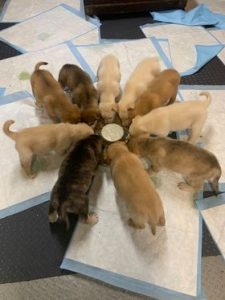By: Parker Pothier One reason many families are hesitant to try fostering is because they are worried about or afraid of the process of saying goodbye. Specifically, families often worry [�]
One reason many families are hesitant to try fostering is because they are worried about or afraid of the process of saying goodbye. Specifically, families often worry about how their kids will handle the goodbye and that they will never be able to �let them go.�
Though saying goodbye can be hard, I assure you, it is not impossible, and it doesn�t have to be as bad as you think! In fact, I have some great strategies that may help you and your kids prepare for the goodbyes and cope with the grief that comes after your foster pet has moved on to their new home.
These are only suggestions, you know your family and what will work for you�take what�s helpful, leave what�s not, and adapt as needed!
1. Start with the end
When you are thinking of fostering or taking in a new pet, remind everyone in the family, adults included, that this is a temporary visitor who is not going to live with you forever. From day 1, keep in mind that this is not your pet, this pet belongs to somebody else and is staying with you for now.
2. Tell the pet about what kind of home you want for them
Verbally saying things like this out loud gets your brain used to the idea that they�re leaving. �I can�t wait to find you a home with no other pets so you can be so comfy there as the king of the castle,� or �I hope they have lots of things that are high up for you to jump and climb on!� or �You are going to have the best life once we find you a home with another doggy or kitty for you to play with!� This can be great dinner table conversation!
3. Get your kids involved in the bio writing and photo taking
Get the kids to write or draw pictures of what the ideal family for your foster animal would be! Get their input! Their �job� is to find the cat or dog a great home, and part of that is dreaming and imagining what that might look like! �What colour of collar or bow tie should we put on the doggy for his adoption photo shoot?� �Do you think a nice photo of our foster dog in the park would help a new family see how friendly and pretty the dog is?� �Do you think our foster cat would get along well with other cats?� �Do you think our foster dog has lots of energy, or just a little bit of energy?� Then, you can send your kids� input along with your own to the Zoe�s team when it comes time to write their bio!
4. As soon as there�s an application, prepare for goodbye
�Hey kids! We got an application to adopt our foster dog! That�s so exciting, and also kind of sad!� Even if the application doesn�t move forward, let them know an application was received and why it did or didn�t get approved. It�s an exciting thing that your pet is wanted, and also good exposure to the goodbye process, even if the inquirers aren�t a good fit. Have the kids make a list for the potential adopters of questions they want to make sure are asked, and maybe get them to help demo some tricks to the potential adopters when they come over for their meet-and-greet!
5. Tell the animal about their new home
This is the same concept as telling them what you�re going to look for. �Foster kitty, I think we found a great home for you! We got an application from a lovely couple who don�t have any kids and want a kitty to keep them company!� �Foster dog, I�m so excited this morning because today some really lovely people are going to come for a visit to see if they want to adopt you!�
Get the kids to draw pictures for the animal of what their new family will look like (the people, the type of dwelling, etc). You can even have the kids be the ones to break the good news to the animal! This will also help the kids learn who is getting the pet, and get comfortable with the idea of what the animal�s new stellar life is going to look like, and reassures them that the animal is going to a great home.
You can also encourage them to write goodbye cards or notes or draw goodbye pictures that you can send along with the adoptive family. They can also help choose a toy to send along with the animal to their new family, to help them feel comfortable.
6. Be realistic about how animals process transition, and don�t turn your animals into humans
Although animals do have thoughts and emotions, they don�t have human thoughts and emotions. They don�t wonder, to an existential level, where you went. They are very �in the moment� and in their new home they are likely thinking, �Oh this is different. This smells funny. All familiarity has escaped me. This is very different!� as opposed to thinking, �Where is my old family? Why didn�t they want me? I miss them so much!�
After a while, just like your foster animal got comfortable with you, they will get comfortable with their new family. You can reassure your kids that your pets do not have feelings that are the same as humans and are not cognitively processing this transition as a personal abandonment.
7. Have a �nesting� phase between foster animals
The nesting phase that happens between foster animals can be very intentional and therapeutic if you want it to be. As a family, you now get to engage in this fun routine where you clean all the bowls, wash the beds and blankets, and set your space up fresh! Kids may love to help set up the cat room that a new foster may hang out in for its first few days in your home, or they might like the opportunity to choose a new location for your new dog�s water bowls to go. You can even facilitate a special trip to one of Zoe�s supply locations to trade out the old bowls for new ones, pick out a new colour for your new foster�s collar, and get some fresh treats!
8. Remember: This goodbye is different than losing a family pet
Saying goodbye to a family pet you have had for many years can be extremely painful. When people imagine saying goodbye to a foster animal, many of them imagine how painful it was when they had to euthanize their family pet(s), or how much it hurt to re-home them after a major life transition. This is a short-term relationship with an animal that is not yours. Typically, you will have a foster pet for 2-6 months. In some cases, families have fosters for longer periods of time, but overall, it is a very short-term relationship. These goodbyes can be fun, too, because you got to help a pet find a forever home, and then you get to say hello to a new foster pet very shortly after!
9. Prepare them ahead of time for adoption day
Before and on adoption day, remind them what�s going to happen and encourage them to be part of it if they want to be. I love to make my foster �presentable� for their new family, so I give them a good brush and maybe even some dry shampoo and get them all ready. The kids might even like to take this time to write goodbye letters, share favourite stories and memories, and talk to the animal about hopes you have for their future.
If your kid doesn�t want to say goodbye or be part of adoption day, that�s okay. Don�t force them, and then afterwards, process it with them. �How did it feel to stay in your room when our foster cat was getting adopted? Did that work for you and feel okay? If it didn�t work for you and you feel like you regret that, is there anything you�d like to do differently next time so you can have the goodbye you wanted? Is there anything you wish you had for support that we haven�t been able to give you so that you feel like you can have a good goodbye? Do you want to say goodbye differently ahead of time, and then still make a plan to not be around when the new family picks them up? Would it work better for you if we made plans for you to be out with grandma or a friend while the new family picks the dog up?�
They may find that being removed from adoption day is genuinely helpful or fine for them, so process it and be open to following their lead. This is their grief journey that they will walk alongside for the rest of their lives in many ways. Kids will experience loss over and over and over as they grow � these foster care goodbyes are great practice for them to learn what works for them when they are grieving.
10. It�s okay to be sad
Loss is an inevitably sad time! Try to avoid telling them not to cry or be sad and let them feel what they feel. If they aren�t talking about it, ask them how they feel. You aren�t going to �make� them sad. If you ask how they feel and they start crying, they were already sad. They likely will become focused on the new foster pet when it arrives, and the sadness will get some redirection. Having photos of the foster animals you have had may help as well! I plan on one day printing out a picture of each of my fosters and having a dedicated space in my apartment for those photos. Maybe your kid needs to hang onto the dog�s old collar for a while, or maybe they would like to have a photo by their bed or in a special album.
11. Kids play through most things that bother them
No matter where you grew up, play was your first language. Kids learn and process things through play. Try to play imagination games with them, where maybe you pretend you�re adopting a new pet and someone in the game is the foster family and can play out that role too. Let the kid take the lead. Look for other ways in their play that they�re saying goodbye and take that as a sign they�re working through it. Did you see them playing with their cars, and someone got in a crash and died? Were they playing with their stuffed animals and then gave one to you and asked you to take care of it? There are so many themes in play that we miss that are actually related directly to experiences our kids are working through day-to-day.�
12. If they�re struggling, get help
If you have any concerns or worries about how your kids are processing grief, bring them to a play therapist who can support your kids in finding ways to process and explore their experiences. The play therapist can also help you as the parents learn how to have these conversations and help your kiddo at home as well. If you need referrals for mental health support for you or your kids, call 211, a nation-wide 24/7 help line that can connect people to low-cost mental health services.
�
Parker has been fostering cats since 2019 and has been a foster cat-dad with Zoe�s Animal Rescue since 2021. Along with fostering cats, Parker has a special passion for working with grieving children and teens. They have facilitated expressive arts-based grief support groups for kids and teens at Pilgrims Hospice Society since 2015. In addition to developing and leading grief workshops and webinars in settings such as conferences, non-profits, and schools, Parker frequents the Child and Youth Care program classrooms at MacEwan University, teaching students about issues related to working with grieving children, teens, and families. Parker is a Therapeutic Support Counsellor at One Tree Psychological and Therapeutic Services, a Community Resource Specialist with the Canadian Mental Health Association, and is a Sandplay Therapy Intern with the Canadian Association for Sandplay Therapy.
Further reading:
Why Foster?
Why I Rescue: A Foster Mom Forever











